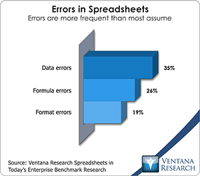Banking giant JP Morgan raised eyebrows in 2012 when it revealed that it had lost a substantial amount of money because of poorly conceived trades it had made for its own account. The losses raised questions about the adequacy of its internal controls, and broader questions about the need for regulations to reduce systemic risk to the banking system. At the heart of the matter were the transactions made by “the London Whale,” the name given to a JP Morgan’s trading operation in the City by its...
Read More
Topics:
Sales,
GRC,
Office of Finance,
Operational Performance Management (OPM),
error,
Business Analytics,
Business Collaboration,
Business Intelligence,
Business Performance Management (BPM),
Data,
Financial Performance Management (FPM),
Information Management (IM),
Sales Performance Management (SPM),
controls
Read More
Topics:
Mobile,
Predictive Analytics,
Real-time,
SAP,
ERP,
Operational Performance Management (OPM),
Analytics,
Business Analytics,
Business Collaboration,
Cloud Computing,
In-memory,
Business Performance Management (BPM),
CRM,
Customer Performance Management (CPM),
finance,
Financial Performance Management (FPM),
Sales Performance Management (SPM),
Supply Chain Performance Management (SCPM),
Workforce Performance Management (WPM),
Social,
Business Suite,
Financial Performance Management,
HANA
Businesses always see a lag between when technology makes some advance possible and when a majority of companies actually adopt it. There’s even a longer lag between the emergence of an advance in a business process or technique and the time it takes to become mainstream. When we write our research agendas at the top of each year, we have to strike a balance between focusing on the new and different, which is still many years away from general acceptance, and the mainstream, which has been...
Read More
Topics:
Big Data,
Planning,
Predictive Analytics,
Governance,
GRC,
Office of Finance,
Operational Performance Management (OPM),
Budgeting,
close,
Analytics,
Business Analytics,
Business Collaboration,
CIO,
Cloud Computing,
In-memory,
Business Performance Management (BPM),
CFO,
Financial Performance Management (FPM),
Risk,
Sales Performance Management (SPM),
Workforce Performance Management (WPM),
CEO,
Financial Performance Management,
FPM
As I’ve noted before, it’s common for CFOs of companies that are transitioning from being a small to a midsize business (that is, when they grow past about 100 employees) to find that the entry-level accounting package that they have been using no longer fits their needs. This software may be inexpensive to purchase and easy to use but it lacks many of the customization and business process management capabilities that become increasingly important as organizations grow. The transition from...
Read More
Topics:
Planning,
Salesforce.com,
ERP,
Human Capital Management,
Office of Finance,
Operational Performance Management (OPM),
Reporting,
close,
closing,
Cloud Computing,
Business Performance Management (BPM),
Financial Performance Management (FPM),
Workforce Performance Management (WPM),
Financial Performance Management,
FinancialForce.com













